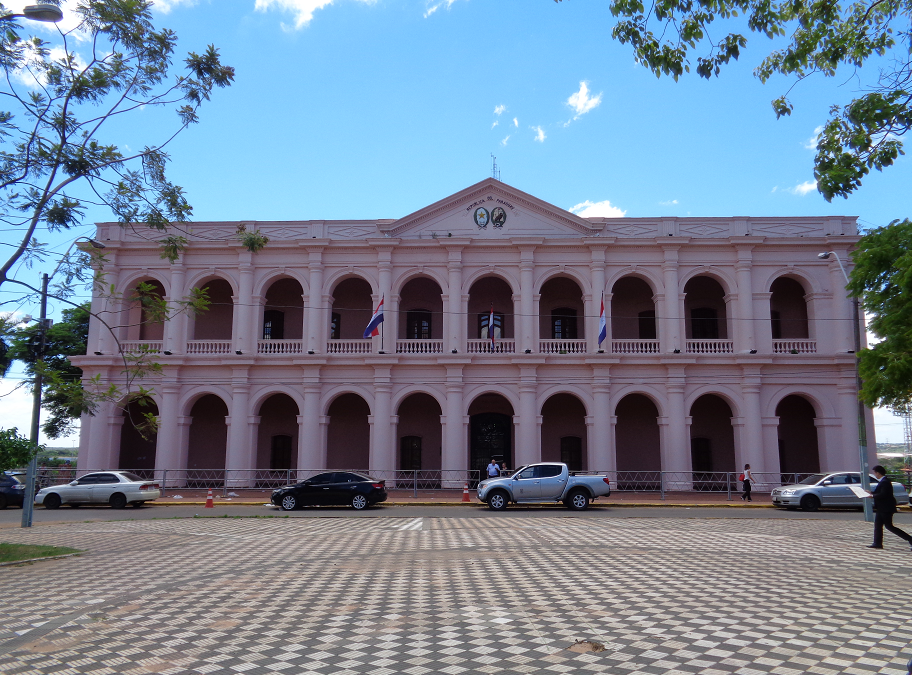The Cabildo or Town Council Building is located at the heart of the historic center of Asuncion. The building occupies one side of the Plaza da la Independencia. Other building also located on the Plaza de la Independencia are the Cathedral and Parliament.
The Cabildo backs onto the Bay of Asuncion and occupies one of the most historic locations in Asuncion. It is placed where the original Fort of Asuncion was built when Asuncion was first established.
The fort was one of the very first building to be built in Asuncion by the Spanish. It was founded in 1541 by Domingo Martinez de Irala. Whilst Asuncion slowly grew the fort was for many years the focal point of the city.
The Cabildo itself was built 300 years later long after the fort had disappeared. Its building was one of many building projects carried out during the presidency of Carlos Lopez in an attempt to modernize the city. Construction of the Cabildo began in 1844 and was completed shortly afterwards.
Once finished it became home to the city council and the legislative center of Asuncion and Paraguay. It was the Paraguayan congress and remained so until the building of a new parliament building in the early 2000s. Aside from a short break caused by the War of the Triple Alliance it remained the seat of the Paraguayan parliament for over 150 years.
One of the reasons for moving parliament to a more modern building was space. The Cabildo contained just one moderately sized debating chamber. Ideal in the mid 19th century but far too small for the requirements of the 21st.
The politicians relocated to their new building in 2003. After that the building was closed for a short while whilst renovations were carried out to prepare it for its new life. Once those were done the Cabildo was reopened in 2004 as a museum housing the Centro Cultural da la Republic.
It is as a museum that the building can now be visited. It is free to enter and has become one of the countries principal museums. The exterior has been given a fresh coat of pink paint and the museum is modern and well laid out.
On the ground floor there is a large ethnographic collection displaying articles from the various indigenous peoples of Paraguay. This includes a tall glass cabinet of ceremonial clothing in the center of one of the rooms.
Also on the ground floor in rooms adjoining the ethnographic collection is a display of religious art. This includes altar pieces and a number of brightly painted wooden statues of saints.
Finally on the ground floor are rooms dedicated to the history of Asuncion and and others used to display temporary exhibits.
From the ground floor the first floor is reached by a wide sweeping staircase. This when the building hosted congress gave the politicians a suitably grand approach to the debating chamber.
One the first floor are exhibits dedicated to more modern aspects of Paraguayan culture. There is a large and interesting collection relating to the history of Paraguayan music and film. A number of items belonging to famed Paraguayan performers are on display here.
Also on the first floor is the old congress chamber. For many years its doors were open and was possible to act at being president taking a seat in his chair. Or sit upon any of the other chairs in the chamber. Regrettably now the doors are closed and the chamber can only be viewed from behind glass.
This museum is a haven a peace in the center of Asuncion. However even in recent history it has not always been so.
In March 1999 students were holding a large anti government protest in the Plaza de la Independencia in front of the Cabildo. Into the crowd gunmen opened fire. Eight protesters were shot dead. The attackers have never been found or identified. There is a memorial to the fallen protesters in the plaza.
Then in May of the following year there was an attempted military coup. This ran out of steam and failed totally. However not before a tank had been driven into the plaza. This opened fire on the Cabildo embedding a shell in its brickwork.
For years the scar left by the tank shell was clearly visible on the front of the Cabildo. It has now though been filled in and painted over. Leaving no trace of the buildings recent dramatic past.


Recent Comments